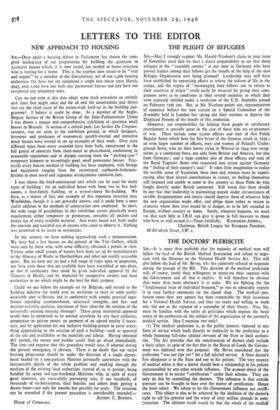LETTERS TO THE EDITOR
Snt,—Once again a housing debate in Parliament has shown the com- plete inadequacy of our preparations for building the 4,000,000 to 5,000s000 houses which, it is now stated, are needed to house everyone who is waiting for a home. This is the number now stated to be " vital and urgent " by a member of the Government, yet of our 1,469 housing authorities 75r have not yet completed a single new house since March, J945, over 1,000 have not built any permanent houses and 929 have not completed any temporary ones.
Can we not even at this date adopt some fresh procedure on entirely new lines that might once and for all end the uncertainties and delays that are the chief cause of the nation-wide hold-up in the building pro- gramme? I believe it could be done. As a member of the Anglo- Belgian Section of the British Group of the Inter-Parliamentary Union I was shown a unique and comprehensive exhibition of specimen small houses in Brussels. A section of a central park, Les yardins Du Cinquan- centaire, was set aside as the exhibition ground, in which designers, inventors and producers of economical, quickly-erected and attractive small houses were invited to set up examples of their work. Over sixty different types from many countries have been built, constructed in the full gamut of materials from sheet-metal to plasterboard, conforming to reasonable regulations and in designs running from the " packing-case " temporary hutment to exceedingly good, small permanent houses. Prac- tically every known method of building has been employed, with fittings and equipment ranging from the stereotyped cupboards-bathroom- kitchen to most novel and ingenious arrangements unknown here.
I was shown the brick-constructed unit which can be used for many types of building: for an individual house with from two to five bed- rooms, a four-family building, or a several-storey fiat-building. We have, as a matter of fact, one example of this ingenious structure near Wimbledon, though it is not generally known, and it could form a most useful addition to the methods of construction now employed. In short, the wide range of possibilities in this exhibition covers practically every requirement, either temporary or permanent, considers all pockets and makes use of every available material. And every house was built under the constant and watchful eye of anyone who cared to observe it. Nothing was permitted to be secret or mysterious.
In this country we have nothing approaching such a demonstration. We have had a few houses on the ground of the Tate Gallery, which were seen by those who, with some difficulty, obtained a permit to view. Various other small groups of houses have been set up by manufacturers or the Ministry of Works in Hertfordshire and other not readily accessible spots. But we have not yet had a full range of types open to inspection, nor have even those that are available here been assembled at one place, so that if satisfactory they could be given individual approval by the Minister of Health, and be inspected by prospective owners and local authorities to see which might be the best for their purpose.
Could we not follow the example set by Belgium, and extend to the building industry the world over an invitation to erect in some easily- accessible spot in Britain, and in conformity with simple, practical regu- lations regarding accommodation, structural strengths, and fire- and weather-resisting qualities, specimens of their ideas for the solution of the universally existing housing shortage? Those given ministerial approval could then be permitted to be erected anywhere by any local authority, corporation or private owner, on payment of an agreed royalty if neces- sary, and by application for one inclusive building-permit to cover every- thing appertaining to the erection of such a building—such as approval of the site and availability of the materials and labour. Having obtained this permit, the owner and builder could then go ahead immediately. The time and expense that this procedure would save, if adopted during the present emergency, is obvious. There is no doubt that our entire housing programme should be under the direction of a single depart- ment headed by a non-partisan Minister personally conversant with the innumerable details of the whole problem and working through the medium of the existing local authorities, instead of, as at present, being handled by seven red-tape-burdened Ministers who, in spite of every good intention, are successfully preventing tens, if not hundreds, of thousands of ex-Servicemen, their families and others from getting a decent home—not only for months but possibly for years. The situation can be remedied if the present procedure is considerably amended.— House of Commons. ALFRED C. BossoM.


































 Previous page
Previous page